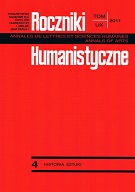Symbole polskiego życia politycznego w Orator Polonus (1740) Samuela Wysockiego
Symbols of Polish Political Life in Orator Polonus (1740) by Samuel Wysocki
Author(s): Magdalena GórskaSubject(s): Cultural history
Published by: Towarzystwo Naukowe KUL & Katolicki Uniwersytet Lubelski Jana Pawła II
Keywords: symbol; emblem; rhetoric; Nobility parliamentarism; political imagination
Summary/Abstract: This paper discusses the function and the origin of over four hundred symbols included in the rhetoric handbook by the Piarist Samuel Wysocki, entitled Orator Polonus (published in Warsaw in 1740). The book is considered an exemplary resource book for parliamentary and local diet speeches and orations of panegyric character. In keeping with the rhetorical practice, the symbola were given the form of arguments, developed on the principle of similitude (similitudo). The author of the handbook was inspired by the compendium by Filippo Picinelli Mundus symbolicus (1681). He used the latter author’s exemplary emblems and symbols and incorporated them to his erudite and moral argumentation. The symbols used by Wysocki promoted an ideal of an exemplary Nobleman and landowner, as well as that of a state officer and a legalist. In this way, Wysocki created a pattern that was distinct from the then-popular emblems. The prevalent pattern related formally to the coats-of-arms, as testified by numerous writings and documentation of the Polish-Lithuanian Commonwealth under the Saxon dynasty. Wysocki’s works are a perfect example of the adaptation of emblems as a genre, with its typical delimitation as regards the choice of theme, symbolic composition and the function of the lemma, deeply rooted in the rhetorical rules and resulting from the political and panegyric interest of the Nobility.
Journal: Roczniki Humanistyczne
- Issue Year: 59/2011
- Issue No: 04
- Page Range: 61-79
- Page Count: 19
- Language: Polish

